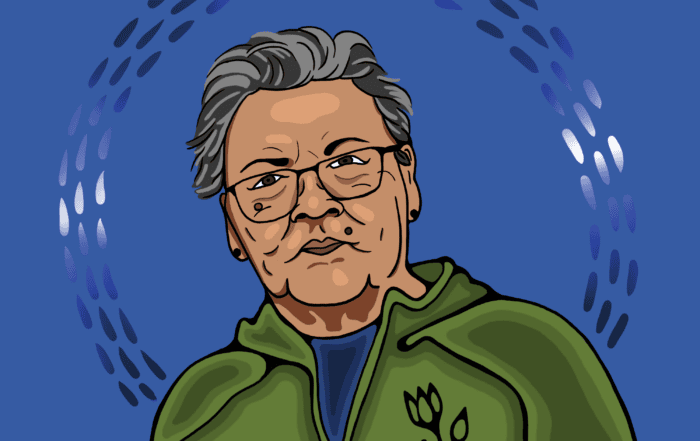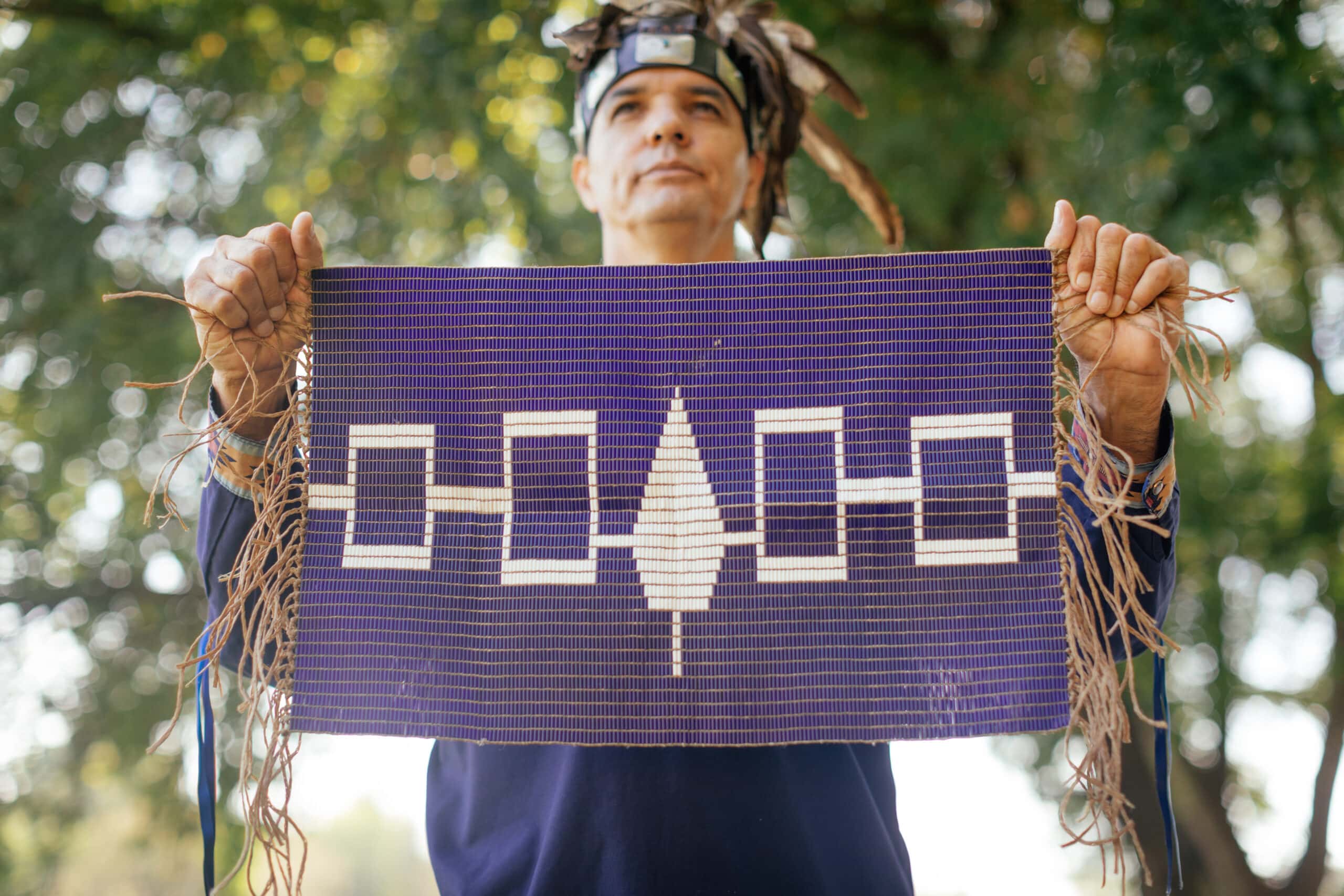
On the banks of the Grand River, Cayuga Faithkeeper and Sub-chief, Leroy (Jock) Hill, holds a glass and twine replica of the Hiawatha Belt. Wampum Belts are an integral part of Haudenosaunee culture, holding laws, treaties and values within their beads. (Photo: Colin Boyd Shafer)
Imagine living in a democratic society whose laws, instructions, and complex governance structure have been upheld for hundreds of years without ever having needed to be written down. Instead, they are preserved by dedicated orators and deft hands, who weave such teachings into glistening rows of purple and white beadwork. This is the reality for the Haudenosaunee, one of the world’s oldest remaining democracies.
Haudenosaunee, means “longhouse builders” in the Seneca language, after our iconic elm wood dwellings. We are also frequently referred to as the Iroquois, the Six Nations Confederacy, or simply onkwehonwe — our word for the “original people” of this land. We have called the Great Lakes home since the Creator originally breathed life into the soil that made our bodies — and we remain connected to the lands and waters to this day.
One of the most recognizable qualities of the Haudenosaunee and, to a lesser extent, other Eastern Woodland cultures, is our many Wampum Belts. These are beaded documents gifted from our ancestors that continue to preserve onkwehonwe’neha, our original ways of being.
At Six Nations of the Grand River, Gayogo̱hó:nǫ’ (Cayuga) Sub-Chief and Faithkeeper Leroy (Jock) Hill shares some of his teachings about the Great Law of Peace, how wampum came to be, and the knowledge threaded into three Wampum Belts: The Great Law of Peace, the Dish with One Spoon and the Two-Row Wampum.
Ot’kó:wa (Wampum)
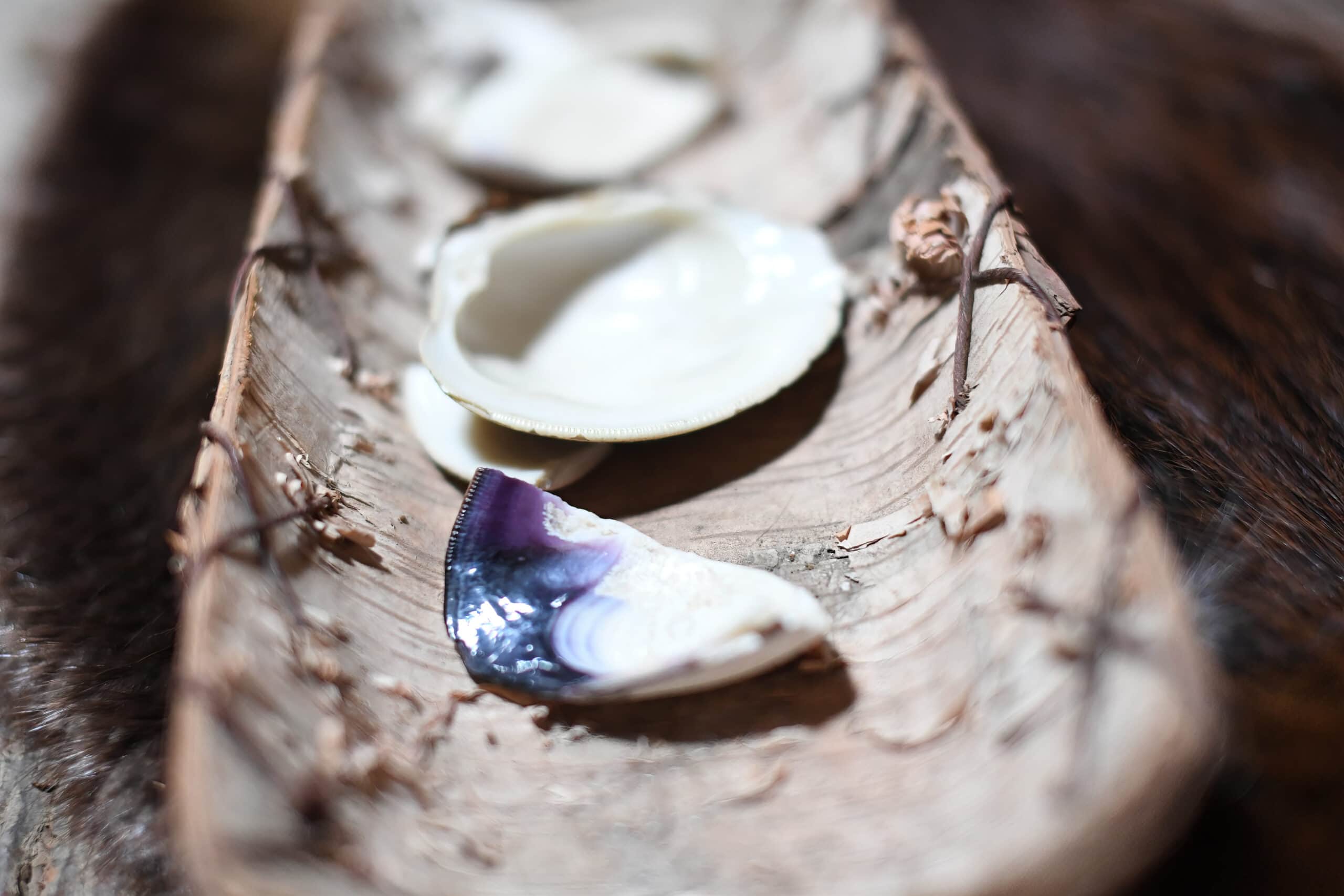
Unprocessed wampum shells bask in the dim sunlight that streams in through the smoke hole of Crawford Lake longhouse. (Photo: Scott Parent)
In almost any story from the Original Peoples of the Great Lakes, you can count on the appearance of animal helpers. That holds true in the way wampum shells came to the Haudenosaunee, as Jock tells us. Their origin dates back to the time when the Haudenosaunee Nations first became one.
One of the figures from this historical moment was an Onondaga man called Aiionwatha, later anglicized as Hiawatha. In addition to his role in bringing peace, Aiionwatha also solidified wampum beads as an undying part of Haudenosaunee culture. Jock explains, “Aiionwatha came to this water, and he thought of all the amazing things that he saw, this power of the good mind, the power of peace,” says Jock.
“And he seen these ducks. Those ducks flew, and here they uncovered wampum. So, there were wampum shells and beads laying all along where them ducks took that water. They moved the water just enough, he could get wampum. So, he went in, filled his bag.”
Aiionwatha realized that these beads could be strung together into designs to create a record of the achievement of peace on Earth, says Jock. “And he got thinking, these things could be used to string up. So Aiionwatha picked up all those shells, all those wampum beads — we say ot’kó:wa, wampum bead.”
The wampum comes from the inner shells of quahog, or hard clam, a bivalve known for its distinctive purple sheen. After collecting the quahog shells, a wampum artisan traditionally uses rock and bone tools to painstakingly shape them into tubular beads. Even with today’s fine power tools, crafting such delicate shapes is incredibly labourious and challenging, highlighting the brilliance of Aiionwatha and other ancestors who would have used bone picks.
Most contemporary beaders use other, more accessible, materials such as clay, glass, and plastic. The beads are then strung together with leather and sinew as a mnemonic device for important teachings.
Kayanere’kó:wa (Great Law)/ The Hiawatha Belt
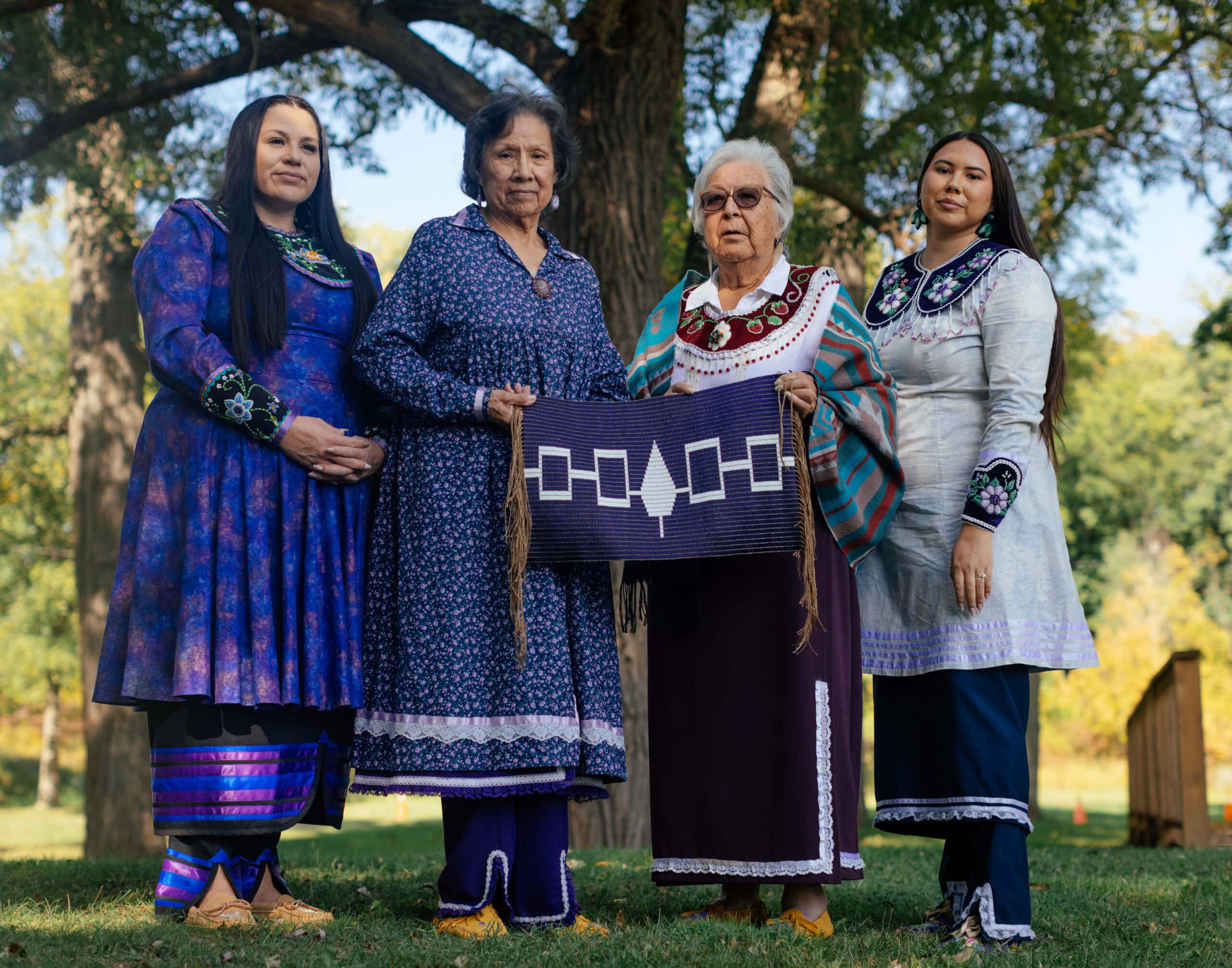
Four Haudenosaunee women in wampum-coloured regalia hold a glass replica of the Hiawatha Belt. Left to right: Karissa John (Mohawk), Clan Mother Mary Sandy (Oneida), Elder Norma Jacobs (Cayuga), Makasa Looking Horse (Mohawk/ Lakota). (Photo: Colin Boyd Shafer)
Jock starts at the beginning, before Aiionwatha strung the first beads together. “Most people know of a period in their history, of a dark age, where it was barbaric and all the bad things that you could imagine humans could do to one another” were done. This is what the Haudenosaunee were going through, almost a thousand years ago.
He says the Creator looked down and saw that the veins of Mother Earth were flowing with the blood of war, senseless killing and other evils. To remind our ancestors how to follow their original instructions, Creator sent the Messenger of Peace, also known as the Peacemaker.
With the help of Aiionwatha, the Messenger travelled by stone canoe. He went to the Mohawk, to the Oneida, to the Seneca and to the Cayuga. One nation at a time, he convinced them to accept the message of peace. Together, these four nations confronted Atotarho of the Onondaga Nation, the most wicked sorcerer and war chief in the region. They showed him the power that lies in peace and cured Atotarho of his evil ways. The Onondaga then joined the other nations and became the central leader of the Haudenosaunee, a role they hold to this day.
Under the Great Tree of Peace, a towering white pine, the chiefs surrendered their weapons. “We’re going to put away the weapons of war so our grandchildren will not see them,” said the Peacemaker, according to Jock. And the Haudenosaunee have remained at peace with each other ever since.
Jock explains they chose a great white pine because each cluster contains five needles, symbolizing the five founding nations. “So that means all of the minds come together in one. And that’s where our true strength and power lies, to forge a future of peace, power and righteousness.” Skén:nen, kasahsten:sera, tahnon skanikonri:io.
The Messenger appointed Tsikonhsahse, an influential Haudenosaunee woman, as the first Clan Mother and installed the clan system, declaring that Haudenosaunee women would play a significant role in society. The Messenger “denoted how important the women’s role is going to be in making peace, and keeping peace, and managing the population to keep everybody at peace,” says Jock. Among other responsibilities, the Clan Mothers would elect chiefs and ensure that they were representing the needs of the community, other living beings, and the coming generations. Today, the traditional chief system has largely been replaced by the Band Council system under the Indian Act, though we still have Clan Mothers.
After Aiionwatha found those initial pieces of wampum, says Jock, “he took them back to Onondaga and showed the Peace Messenger and Atotarho. They worked together, along with the women, and they strung them up in the pattern.” Aiionwatha told the others: ‘this is going to be the record of peace on Earth.’ So when people see this, it’s going to work on their minds that we [Haudenosaunee] achieved peace.” And so, Aiionwatha created the first Haudenosaunee Wampum Belt, now known as the Hiawatha Belt.
When Aiionwatha designed the belt, he arranged the symbols of each nation in relation to their geography. East to West, the belt represents: the Mohawk, Oneida, Onondaga, Cayuga, and Seneca. The Messenger of Peace designated the Mohawk and Seneca as the Keepers of the Eastern and Western Doors, respectively. Jock explains that an idea or issue flows in through those doors, then passes to the little brother nations, the Oneida and the Cayuga. “Once it’s unanimous, it goes to the firekeepers, the Onondaga, to resolve– to make final resolution.”
Hundreds of years later, in 1722, the Tuscarora would join the Haudenosaunee, forming the 6 Nations as we are known today. Almost 120 Haudenosaunee laws that the Peacemaker brought to maintain peace, are enumerated in Aiionwatha’s belt. It’s unequivocally the most foundational document of our confederacy.
Now, the Wampum continues to work on our minds the way those ancestors intended. The Hiawatha belt, which holds this knowledge in its beads, has become the most ubiquitous symbol of the Haudenosaunee. Cloth versions can be seen flying on the flagpoles of our allies all around the world.
Sewatokwà:tshera (The Dish with One Spoon)
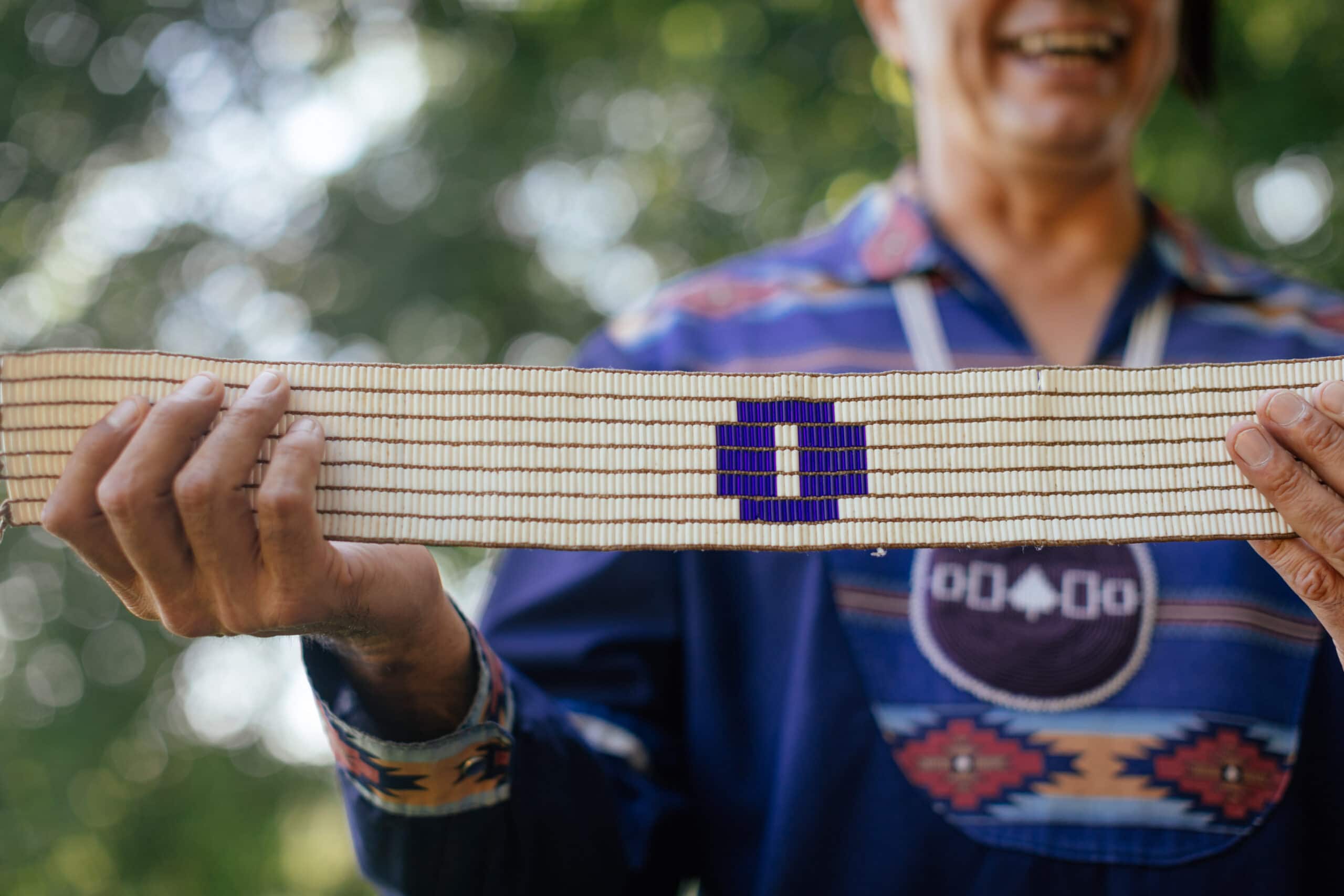
Jock holds up a glass replica of the Dish with One Spoon, reminding the small audience of our responsibilities to each other, the Earth, and future generations. (Photo: Colin Boyd Shafer)
The Peacemaker recognized that hunting territories were a major point of contention among all the nations in the region. He instructed the Haudenosaunee as to how they needed to interact with all our other relations — humans and more-than-human — to maintain the peace. The Dish with One Spoon Wampum is a pre-colonial treaty between the Haudenosaunee and Anishinaabe that is still honoured today.
“We’re placing everything in one dish,” Jock says. “One dish is going to hold all what Mother Earth holds… Symbolically, he put cooked beavertail in a wooden one-dish, [and] said we all can take a piece off of that. And that’s representing all the things that sustain humans and sustain life.”
“We all are entitled to a piece of that. Nobody owns the dish. But we all have equal responsibility… so that the next people coming can have access, and the coming faces can have what’s there in the dish.”
Ohwentya’konta yakosonten’iénke, the “coming faces” in Kanyen’kéha, is how the Haudenosaunee talk about future generations. We think about those generations living with the choices we make today, as future ancestors, but their faces are not yet formed. When a decision is made, it must be done with consideration for all the ohwentya’konta yakosonten’iénke.
Peace is still an integral part of this Wampum, as the Haudenosaunee and Anishinaabe had been fearsome enemies for centuries. “We’re going to have to keep the knife out of that dish, because if we had a sharp instrument like a knife, that would draw blood again and it would cause us to go back to warfare. So, some say, well, you can use a spoon because it’s not sharp. So that’s where this concept of one dish and one spoon come from.”
Colour plays a part in the symbolism, too. “The white around [the dish] represents all of the goodness on Earth. So good mind, charity, compassion, sharing and caring, all of those,” says Jock. “All of those values are what governs our behavior with the dish.” While the Dish with One Spoon is often co-opted by environmental sustainability groups as a reminder to consume less, the belt is as much about our human responsibility to other humans as it is to the environment.
In the current colonial context, this Wampum Belt also reminds the Haudenosaunee and the Anishinaabe of an age-old agreement to one another. In Dish with One Spoon territory, we raise each other up, making space for both culture and language groups to thrive. In urban communities of mixed peoples, especially, we have to be conscious that one voice or culture doesn’t become dominant over the other.
No wampum, however, has managed to prevent the Haudenosaunee and the Anishinaabe from ribbing each other about select cultural differences, such as dancing in opposite directions. It’s the classic “nobody punches my brother but me” rule.
Teyohate Kahswentha (the Two-Row Wampum)
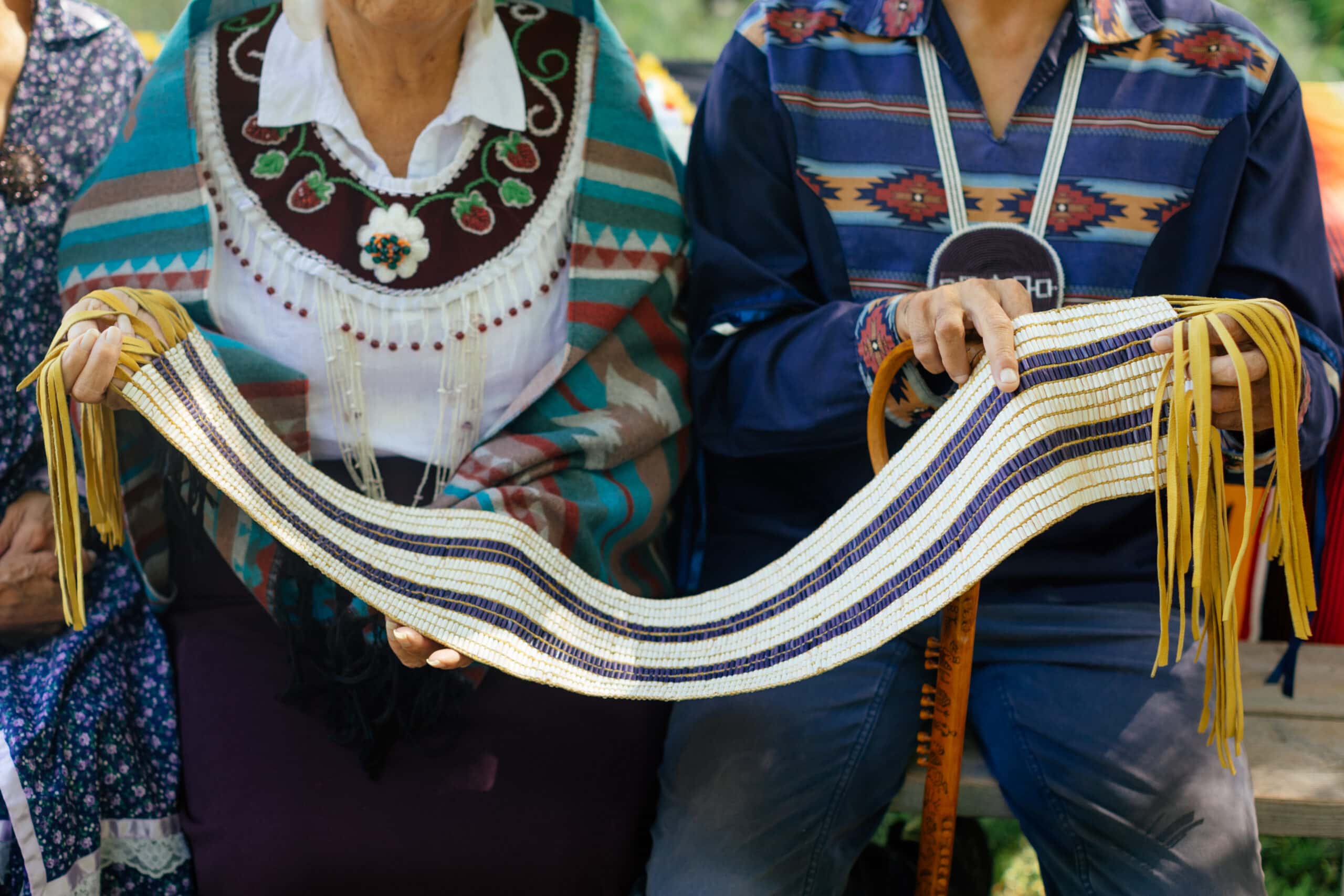
Jock Hill and Norma Jacobs hold a clay replica of the Two-Row Wampum, which represents early agreements between the Haudenosaunee and European settlers. (Photo: Colin Boyd Shafer)
The Haudenosaunee “must work to extend that branch of peace to all [we] encounter,” says Jock, according to the instructions given by the Peacemaker. As designated “Keepers of the Eastern Door,” it was the Mohawk who discovered the Europeans imposing westward along the St. Lawrence River.
The Mohawk brought this information to the Haudenosaunee council fire and “our people saw that we’ve got to sit down, and we’ve got to work out how we’re going to coexist,” says Jock. All kinds of European nations would arrive at the Eastern Door in the coming decades.
The Haudenosaunee helped early settlers by sharing medicines and teaching them how to survive in this environment which was new to them. We were simply “practicing these laws that the Creator sent to us about assisting others,” says Jock.
Eventually, “they shook hands, and they made friendship,” says Jock, gesturing to the two rows beaded into the Wampum, side-by-side. The Haudenosaunee and the Europeans co-created the Two-Row Wampum to acknowledge the sovereign rights of the other. While this Wampum was first made with Dutch settlers, it was later transferred to the British in 1664 when they took over the New Netherlands settlements.
The two purple rows signify the path of the Dutch in a ship and the Haudenosaunee in a canoe, respectively. Each vessel contains language, culture, laws, and ways of being. Jock explains the original intention, “you keep in the ship and we’ll keep in a canoe and we’ll travel through the river of life together.”
They agreed that the two vessels would continue in parallel without ever crossing paths. “That means we won’t interfere with one another’s laws and traditions. So that’s been broken,” he points out, “but it’s still a law we’re adhering to on our side.”
The three white rows on the wampum symbolize the “principles of a good mind, of peace and friendship and mutual aid,” Jock says. “So, we have some really beautiful laws that are meaningful to this day, that we’re still doing our best to adhere to and promote, and to reconnect our people with. That’s the race that we’re in as humans, as Haudenosaunee.”
The original Two-Row Wampum was “meant to last as long as the rivers flow, as long as the grass grows green, and as long as the sun is in motion.” In this new era of decolonialization and Indigenous resurgence, it’s becoming possible for both sides to return to the boats of their respective ancestors.

